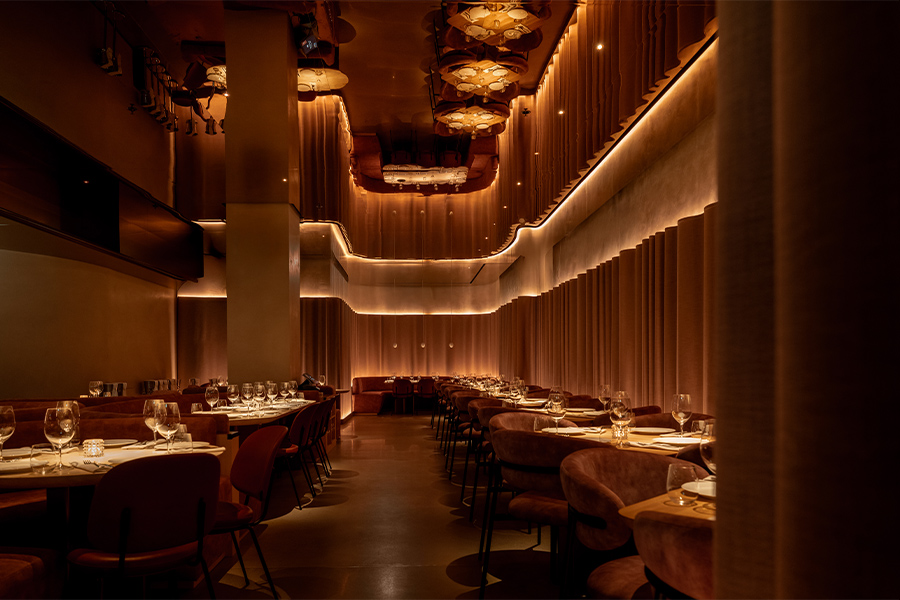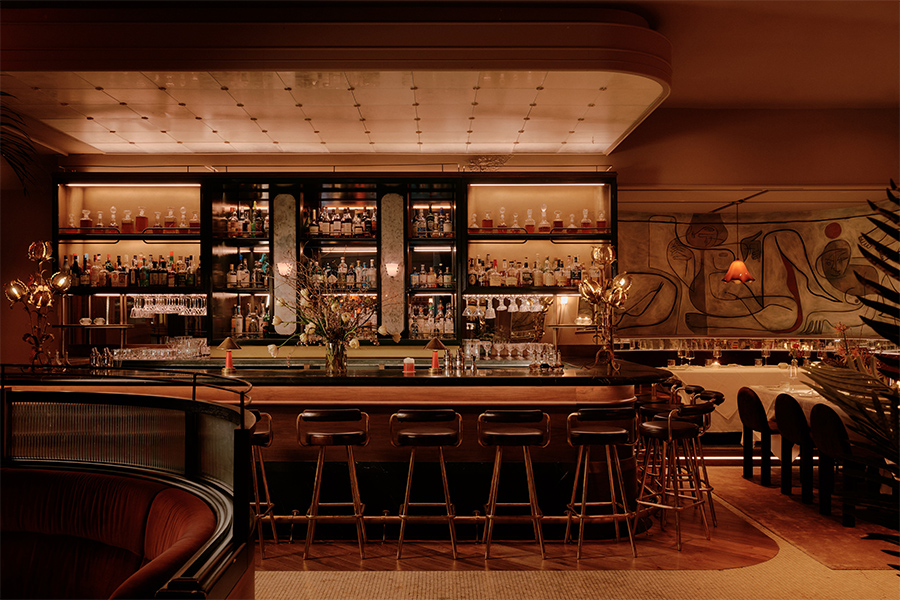Fast causal need not compromise quality in dishes or design. Below, we visit playful environments across the globe that invite guests to linger thanks to inventive color palettes that that maximize modest footprints.
Scotts Taikoo Li
Chengdu, China

At Scotts Taikoo Li in Chengdu, London-based design firm Unknown Works mimicked traditional English fish and chips shops for a minimal, avant-garde design. Using 3D scans of elements and textures from outposts in the UK, including the original Scotts in Yorkshire, the exterior’s articulated fiberglass panels—finished in alabaster white and reinforced with plastic—evoke everything from wallpaper textures to saltshakers and nautical knickknacks. They also double as furniture, unfolding from the center as tables. “With the interior space limited for dine-in guests and the exterior envelope such a visible marker for the site, it was obvious the façade should play a key role,” says the studio’s director and cofounder Ben Hayes. “It’s both an active space for [patrons] to inhabit as well as the conceptual framework for the entire restaurant.”
Biggy
Wrocław, Poland

To recreate an American-style bar that serves Detroit-style pizza and burgers in the heart of Wrocław, local firm BUCK.STUDIO converted a 540-square-foot space in Old Town into the alluring fast casual restaurant Biggy, with colorful details anchored in a contemporary minimalism. For a nostalgic pastiche, “the ’90s street style-inspired primary colors take full responsibility for the character of the venue,” says head designer Pawel Buck. Indeed, shades of red, blue, and yellow mingle with tongue-in-cheek neon signs (“You Wanna Pizza Me?” reads one that sits above a seating area) throughout the kitschy, eclectic, and decidedly retro space. The challenge, says Buck, was making the narrow layout inviting and welcoming. Metal mesh partitions organize the interior, creating various zones that “emphasize the casual, liberal atmosphere of the place,” he says
Billie Buoy
Melbourne, Australia

“It’s retro-cool reimagined in 2020,” says designer Jean-Pierre Biasol of Billie Buoy in Melbourne’s Essendon suburb. The compact 700-square-foot eatery is brimming with personality and nostalgic 1980s references. “The service counter and neon signs capture the vibe of the decade, while old school tunes play in the background,” says Biasol, founder of his local namesake firm. A color palette of rich blue accented by hot pink mixes with materials like terrazzo, mosaic tiles, rendered walls, and felt upholstery to create a rich and youthful environment. Arched shapes—including a curved tunnel that leads to additional banquette seating in the rear dining area—are on display throughout as a way to bring down the height and soften the point between the ceiling and the wall. Outside, the playful aesthetic continues with an Instagram-worthy mural depicting the phrase “Wake Me Up When I’m Famous” covering the corner building’s exterior. “For us,” says Biasol, “Billie Buoy is a look back to the days where wifi was nonexistent and being present meant something.”
BaseHall
Hong Kong

Since culinary haven BaseHall occupies the basement of Hong Kong landmark Jardine House, Shanghai-based Linehouse drew inspiration from historical depictions of the iconic tower, particularly a 1970s cinema eclectic material palette, including a custom metal canopy, lacquered ceiling panels, and a radiant lighting design that compensates for a lack of sunlight and “highlights Hong Kong’s heritage and the retro nostalgia of the period,” explains Linehouse cofounder Briar Hickling. Subtle references to Hong Kong’s urban landscape, such as laurel green tones that echo traditional shop gate decorations, also infuse an artful sense of place across the dual-level food hall. The bright and buzzy market courtyard is anchored by seven artisanal food vendors, while a warmer, more intimate bar occupies the upper level with green rounded battan wall panels and a dusty pink bar topped with upcycled marble. “The ambiance allows for people to come at different times of the day and occupy different zones within the space depending on the occasion,” she adds.

Photos by Pion Basia Kuligowska, Przemysław Nieciecki, Timothy Kaye, and Dennis Lo, and courtesy of Unknown Works
A version of this article originally appeared in HD’s September 2020 issue.



